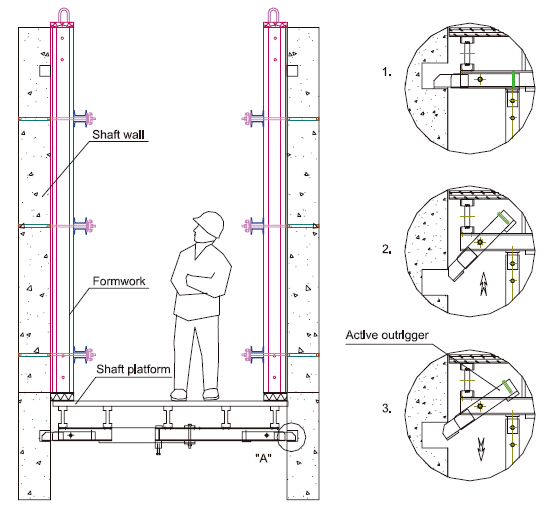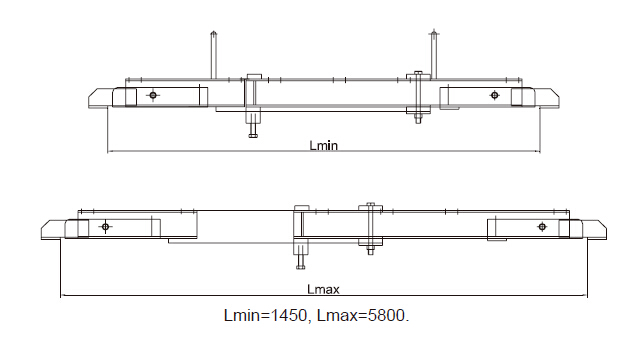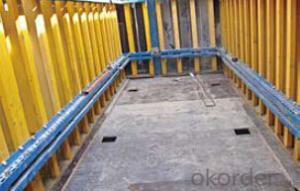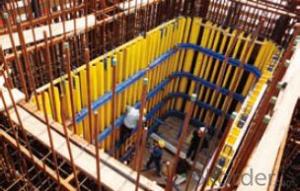Shaft-platform System For Formwork and Scaffolding
- Loading Port:
- Tianjin
- Payment Terms:
- TT OR LC
- Min Order Qty:
- 50 m²
- Supply Capability:
- 1000 m²/month
OKorder Service Pledge
Quality Product, Order Online Tracking, Timely Delivery
OKorder Financial Service
Credit Rating, Credit Services, Credit Purchasing
You Might Also Like
Shaft Platform
As operating platform, the shaft platform is mainly used in the concrete pouring of elevator shaft,
equipment shaft, stair shaft of high-rise building and so on.
Characteristics:
◆ The length of shaft beam is adjustable.
◆ Flexible structure makes lifting easier.


- Q:Are there any specific safety measures to be followed during steel formwork installation?
- Yes, there are specific safety measures that should be followed during steel formwork installation. Here are some of the most important ones: 1. Personal Protective Equipment (PPE): All workers involved in the installation of steel formwork should wear appropriate PPE, including safety helmets, gloves, safety glasses, and steel-toed boots. This will help protect against potential head injuries, hand injuries, eye injuries, and foot injuries. 2. Training and Competency: Workers should be properly trained and competent in the installation of steel formwork. They should have a good understanding of the equipment being used, the proper installation techniques, and the potential hazards associated with the work. 3. Equipment Inspection: Before starting the installation process, all formwork equipment, including steel frames, braces, and connectors, should be inspected for any damage or defects. Any damaged or defective equipment should be taken out of service and replaced. 4. Secure and Stable Platform: A secure and stable platform should be established for workers to safely install the steel formwork. This may involve the use of scaffolding or other supporting structures. The platform should be properly erected and inspected for stability before work begins. 5. Fall Protection: Fall protection measures should be in place to prevent workers from falling while installing the steel formwork. This may include the use of guardrails, safety harnesses, and safety nets. Workers should be properly trained in the use of fall protection equipment and procedures. 6. Lifting and Handling: Proper lifting and handling techniques should be used when moving and positioning steel formwork. Workers should avoid overexertion and use mechanical aids, such as cranes or hoists, when necessary. Additionally, workers should be mindful of their posture and avoid awkward or strenuous lifting positions. 7. Communication and Coordination: Effective communication and coordination among workers is crucial during steel formwork installation. This includes clear instructions, proper signaling, and a designated person in charge of coordinating the work. This will help prevent accidents and ensure a smooth and safe installation process. By following these safety measures, the risk of accidents and injuries during steel formwork installation can be significantly reduced, creating a safer working environment for all involved.
- Q:What is the lifespan of steel formwork compared to other types of formwork?
- The lifespan of steel formwork is generally longer compared to other types of formwork. Steel is a highly durable material that can withstand frequent use and harsh construction conditions. It has excellent resistance to wear, corrosion, and impact, making it a preferred choice for long-term projects. Additionally, steel formwork can be easily repaired and reused, further extending its lifespan.
- Q:What are the different types of supports used in steel formwork systems?
- There are several types of supports used in steel formwork systems, including adjustable steel props, scaffolding, bracing systems, and shoring systems. These supports are designed to provide stability and structural integrity to the formwork system during the concrete pouring process.
- Q:What are the different types of scaffolding used with steel formwork?
- There are several different types of scaffolding that can be used with steel formwork, each with their own unique features and benefits. 1. Tube and Coupler Scaffolding: This is the most commonly used type of scaffolding with steel formwork. It consists of vertical tubes connected by couplers, which allow for easy adjustment and flexibility in height and width. It is known for its strength and stability, making it suitable for heavy-duty construction projects. 2. H-frame Scaffolding: This type of scaffolding is similar to the tube and coupler system, but it features H-shaped frames instead of vertical tubes. It is lightweight and easy to assemble and disassemble, making it ideal for small-scale construction projects or areas with limited space. 3. Cuplock Scaffolding: Cuplock scaffolding is a modular system that uses pre-fabricated components, including vertical standards with cup joints and horizontal ledgers. It is quick to assemble and dismantle, making it a popular choice for time-sensitive projects. Cuplock scaffolding is also known for its versatility, as it can be used for both straight and curved structures. 4. Ringlock Scaffolding: This type of scaffolding is similar to cuplock scaffolding, but it uses a rosette joint system instead of cups. This allows for greater flexibility in assembling and adjusting the scaffolding. Ringlock scaffolding is known for its durability and high load-bearing capacity, making it suitable for heavy construction projects. 5. Kwikstage Scaffolding: Kwikstage scaffolding is a modular system that uses pre-fabricated components, including standards, ledgers, and transoms. It is quick to assemble and dismantle, and it offers excellent flexibility in terms of height and width adjustments. Kwikstage scaffolding is commonly used in construction projects that require frequent movement and repositioning of scaffolding. Overall, the choice of scaffolding used with steel formwork depends on the specific requirements of the construction project, including factors such as load-bearing capacity, flexibility, ease of assembly, and durability.
- Q:What are the different types of formwork anchors used in steel formwork?
- Steel formwork commonly uses various types of formwork anchors to secure the formwork to the structure and ensure construction process stability and safety. Examples of these formwork anchors include: 1. Wedge Anchor: This anchor has a threaded rod with a wedge-shaped end. By inserting it into a pre-drilled hole in the concrete structure and tightening a nut on the threaded end, a strong grip is formed. It is commonly used to secure formwork to concrete walls or slabs. 2. Screw Anchor: Also known as self-tapping anchors, these anchors are designed for use in softer materials like wood or light-gauge steel. They have a threaded body that can be screwed into the material, providing a secure connection for the formwork. Screw anchors are popular for temporary formwork applications due to their easy installation and removal. 3. Hook Anchor: This hook-shaped anchor is typically embedded into the concrete structure during the pouring process. The formwork is then attached to the hook using bolts or fasteners, creating a strong and reliable connection. Hook anchors are commonly used in applications with high loads or lateral forces. 4. Swift Lift Anchor: Specifically designed for lifting and handling precast concrete elements, including steel formwork, these anchors are embedded into the structure during pouring. They provide a safe and efficient method for lifting and positioning the formwork. 5. Plate Anchor: Plate anchors consist of a flat plate with holes for bolts or fasteners. They are versatile and commonly used in steel formwork systems to secure the formwork to the structure. Plate anchors can be easily adjusted or relocated as needed. 6. Chemical Anchor: Chemical anchors are used when a strong and permanent connection is required. They consist of a resin or adhesive injected into a pre-drilled hole in the concrete structure. The steel formwork is then attached to the chemical anchor, creating a secure bond. Each type of formwork anchor has unique advantages and is suitable for different applications. Factors such as the type of structure, load requirements, and duration of use should be considered when selecting the appropriate anchor and ensuring proper installation for the safety and stability of the formwork system.
- Q:What are the different types of release agents used with steel formwork?
- There are several types of release agents used with steel formwork, including petroleum-based agents, water-based agents, silicone-based agents, and wax-based agents. These release agents are applied to the surface of the formwork to prevent the concrete from sticking to it during the pouring and curing process. Each type of release agent has its own advantages and suitability for different applications, depending on factors such as the desired finish, ease of application, and environmental considerations.
- Q:What are the different types of steel used in formwork construction?
- Formwork construction utilizes various types of steel, each possessing distinct characteristics and applications. 1. Mild Steel: The most frequently employed steel in formwork construction, mild steel offers affordability, availability, and ease of handling. It is suitable for numerous formwork applications, boasting commendable strength and durability. 2. High Tensile Steel: Distinguishing itself from mild steel, high tensile steel exhibits superior strength and tensile properties, rendering it ideal for robust formwork structures. Its ability to resist bending and deformation under heavy loads makes it particularly fitting for extensive construction projects. 3. Reinforcing Steel: Also referred to as rebar, reinforcing steel reinforces concrete structures in formwork construction. Typically composed of carbon steel, it comes in various grades and sizes. Reinforcing steel is employed to enhance concrete's tensile strength, diminish cracking, and prevent structural failure. 4. Stainless Steel: When prioritizing resistance to corrosion, formwork construction turns to stainless steel. This material excels in environments with harsh conditions or exposure to corrosive substances. Its exceptional resistance to corrosion results in a long-lasting and durable choice for formwork construction. 5. Alloy Steel: Utilized in formwork construction for its augmented properties, alloy steel combines with other elements to enhance its characteristics. This type of steel is commonly employed for its high strength, toughness, and resistance to wear and tear. Formwork systems requiring outstanding performance and durability often rely on alloy steel to withstand substantial loads. Ultimately, the selection of steel for formwork construction hinges upon project-specific requirements, encompassing load-bearing capacity, durability, and corrosion resistance. The appropriate type of steel must be chosen to guarantee the safety and longevity of the formwork structure.
- Q:Can steel formwork be used in industrial construction projects?
- Certainly, steel formwork is a viable option for industrial construction projects. Renowned for its robustness, durability, and ability to bear heavy loads, steel formwork proves suitable for demanding applications such as industrial construction. It can effectively withstand the immense pressure exerted by substantial concrete pours and can be used repeatedly, making it a cost-effective choice for extensive undertakings. Moreover, steel formwork guarantees a smooth and consistent finish to the concrete structure, ensuring exceptional quality outcomes. Furthermore, it offers adaptability in design, allowing for customization to cater to the specific needs of industrial construction ventures. In summary, steel formwork presents itself as a dependable and efficient solution for industrial construction projects.
- Q:Can steel formwork be easily dismantled and removed after construction?
- Yes, steel formwork can be easily dismantled and removed after construction. Its modular design allows for quick and efficient disassembly, making it suitable for repetitive use in various construction projects. Additionally, steel formwork is known for its high strength and durability, ensuring that it can withstand the rigors of construction while still being easily dismantled when no longer needed.
- Q:How does steel formwork affect the overall sound insulation of a structure?
- Steel formwork has a significant impact on the overall sound insulation of a structure. Due to its dense and rigid nature, steel formwork tends to transmit sound vibrations more efficiently compared to other materials such as wood or plastic. This means that if steel formwork is used extensively in a building's construction, it can potentially reduce the sound insulation capabilities of the structure. The transmission of sound through steel formwork occurs mainly through three mechanisms: airborne sound, impact sound, and structure-borne sound. Airborne sound refers to sound waves traveling through the air and being transmitted through the steel formwork. Impact sound occurs when a sound wave hits the steel surface, causing it to vibrate and transmit the sound further. Structure-borne sound refers to vibrations traveling through the steel formwork and being transmitted to other parts of the building. To mitigate the negative impact of steel formwork on sound insulation, various measures can be taken. One approach is to use additional sound-absorbing materials, such as acoustic panels or insulation, on the interior surfaces of the structure. These materials can help reduce the transmission of airborne sound waves and dampen the vibrations caused by impact or structure-borne sound. Additionally, proper sealing and jointing of the formwork can minimize the leakage of sound through gaps or cracks. It is important to note that the overall sound insulation of a structure is not solely dependent on the formwork material. Other factors, such as the thickness of walls, type of insulation used, and the design of windows and doors, also play a crucial role. Therefore, while steel formwork may have a negative impact on sound insulation, it is possible to compensate for this by employing appropriate acoustic design strategies and incorporating soundproofing techniques throughout the building's construction process.
1. Manufacturer Overview |
|
|---|---|
| Location | |
| Year Established | |
| Annual Output Value | |
| Main Markets | |
| Company Certifications | |
2. Manufacturer Certificates |
|
|---|---|
| a) Certification Name | |
| Range | |
| Reference | |
| Validity Period | |
3. Manufacturer Capability |
|
|---|---|
| a)Trade Capacity | |
| Nearest Port | |
| Export Percentage | |
| No.of Employees in Trade Department | |
| Language Spoken: | |
| b)Factory Information | |
| Factory Size: | |
| No. of Production Lines | |
| Contract Manufacturing | |
| Product Price Range | |
Send your message to us
Shaft-platform System For Formwork and Scaffolding
- Loading Port:
- Tianjin
- Payment Terms:
- TT OR LC
- Min Order Qty:
- 50 m²
- Supply Capability:
- 1000 m²/month
OKorder Service Pledge
Quality Product, Order Online Tracking, Timely Delivery
OKorder Financial Service
Credit Rating, Credit Services, Credit Purchasing
Similar products
New products
Hot products
Related keywords























